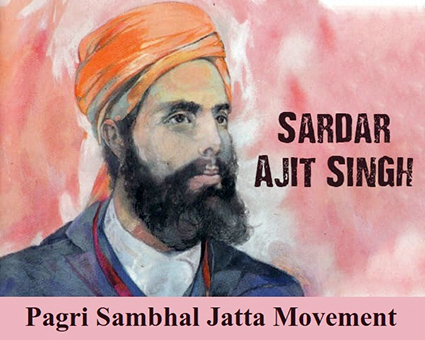Indian History
Pagri Sambhal Movement
- 24 Feb 2021
- 5 min read
Why in News
The Samyukta Kisan Morcha (SKM) is celebrating 23rd February as Pagri Sambhal Diwas, honouring the memory of Ajit Singh-founder of the Pagri Sambhaal Movement of 1907.
- Farmer unions part of the ongoing protests in Delhi claim that farm laws passed by Parliament will ultimately force them to sell their land to corporates. It was a similar complaint that fueled the farm protests in 1907.
Key Points
- Pagri Sambhal Movement:
- About:
- It was a successful farm agitation that forced the British government to repeal three laws related to agriculture back in 1907.
- The Punjab Land Alienation Act 1900, the Punjab Land Colonisation Act 1906 and the Doab Bari Act 1907.
- These acts would reduce farmers from owners to contractors of land, and gave the British government the right to take back the allotted land if the farmer even touched a tree in his field without permission.
- It was a successful farm agitation that forced the British government to repeal three laws related to agriculture back in 1907.
- Slogan:
- The slogan, Pagdi Sambhal Jatta, the name of the movement, was inspired by the song by Banke Lal, the editor of the Jang Sayal newspaper.
- Protest:
- The protests were violent and the protestors ransacked government buildings, post offices, banks, overturning telephone poles and pulling down telephone wires.
- Leader of the Agitation:
- Bhagat Singh’s uncle Ajit Singh was the force behind this agitation.
- He wanted to channel people’s anger over the farm laws to topple the colonial government.
- Bhagat Singh’s father Kishan Singh and uncle Ajit Singh, with their revolutionary friend Ghasita Ram, formed Bharat Mata Society, aiming to mobilise this unrest into a revolt against the British government.
- Many young revolutionaries like Sufi Amba Prasad, Zia-ul-Haq, Lal Chand Falak, Din Dayal Banke, Kishan Singh and Lala Ram Saran Das were among the members of Bharat Mata Society.
- About:
- Sardar Ajit Singh:

- Birth:
- Born on 23rd February, 1881 he was an Indian revolutionary, an Indian dissident and a nationalist during the colonial era.
- He was an inspiration to Indian revolutionaries and his nephew Bhagat Singh.
- Work:
- He openly criticised the colonial government and was amongst the early protests in Punjab.
- With his brother Kishan Singh, worked among the people in famine-stricken regions like Barar (Madhya Pradesh) and Ahmedabad and in flood-and-earthquake-affected areas of Srinagar and Kangla in 1905.
- He launched the Bharat Mata Book Agency ( part of Bharat Mata Society), which, because of its strident anti-government, propagandist publications, attracted the attention of the British government.
- He built a network of solidarity with people who were struggling for India’s liberation in different parts of Europe. He also founded in this period the Indian Revolutionary Association (Bharatiya Krantikari Sangh).
- Exile:
- In May 1907, Sardar Ajit Singh along with Lala Lajpat Rai was exiled to Mandalay in Burma.
- However, due to great public pressure and apprehension of unrest in the Indian Army, both of them were released in October 1907.
- Escape:
- In 1909, Sardar Ajit Singh along with Sufi Amba Prasad escaped to Iran and lived in a self-imposed exile for 38 years.
- Death:
- In March 1947, he returned to India and died on 15th August 1947, the day India gained independence at Dalhousie, Punjab.
- Birth:
Note:
- During the medieval period, only noblemen were allowed to wear a turban but during the Sikh revolution in the 17th century, Guru Gobind Singh declared it as a symbol of defiance.
- He subverted the selectiveness of a turban, providing the common man with a way to claim and assert their own self-esteem.
- Pagri (Turban) represents the dignity of the common man.
- In 1907, Pagri Sambhal Jatta was a call to not let the Pagri fall, literally and figuratively.




